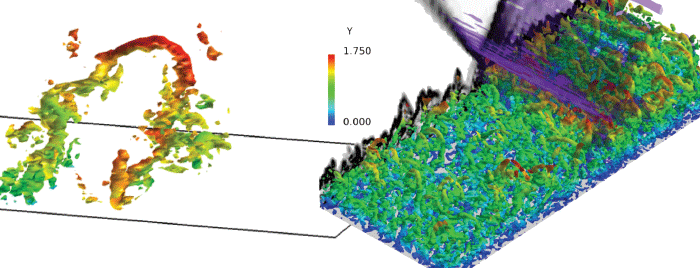Simulations developed by a research team led by Datta Gaitonde at The Ohio State University depict the effect of impinging and reflecting shocks on coherent structures in the boundary layer.
The interactions between shock waves from supersonic aerospace vehicles and the airflow immediately adjacent to their exterior surfaces, referred to as shock boundary layer interactions, can have significant effects on the design and performance of wings, control surfaces and propulsion systems. Unsteadiness caused by the shocks can lead to thermal and mechanical stresses that can lead to degradation of performance or outright failure of a vehicle.
Experimental research is underway to control the unsteadiness using plasma actuators to generate and introduce heated plasma into the airflow. At the same time, computational research related to these experiments is being conducted to generate a better understanding of these control mechanisms and determine how to improve them. Large Eddy Simulations – mathematical models for turbulence – are needed to understand the physics of both baseline and controlled cases.
To develop this capability, Datta Gaitonde, Ph.D., a professor of mechanical and aerospace engineering at The Ohio State University, and his team, are conducting a systematic research program leveraging the computational power of the Oakley Cluster at the Ohio Supercomputer Center. The challenge of the first stage involved generating a supersonic turbulent boundary layer that demonstrated the expected mean and statistical properties and contained the proper coherent structures.
“It is computationally expensive and theoretically difficult to simulate natural transition, and often, the computational overhead of simulating the transition of the flow is larger than that of the main shock interaction,” said Gaitonde, the John Glenn Chair and an Ohio Research Scholar.
Simulations on fine, medium and coarse mesh resolutions show that the medium grid reproduces most of the behavior of the fine grid, making it a suitable grid for future shock/turbulent boundary-layer interactions (STBLI) studies, whereas the coarse grid has a relatively delayed transition, affecting its ability to have the same qualitative and quantitative results as the fine grid. The evidence suggests that the coarser mesh results are consistent with delayed transition and may, in fact, reproduce many of the key features of turbulence if the transition length can be shortened.
Recently, these results have been employed to perform the full STBLI, using a combination of OSC and Department of Defense machines. The results are very promising, in that the two major features of interest, flow separation and unsteadiness, are both successfully modulated. Current efforts are focusing on determining the “sweet spot” for control techniques.
Project Lead: Datta Gaitonde, The Ohio State University
Research Title: Spatially developing supersonic turbulent boundary layer with a body-force-based method
Funding Source: U.S. Air Force Office of Scientific Research, Ohio Research Scholars Program
Website: http://hfcmpl.osu.edu/

